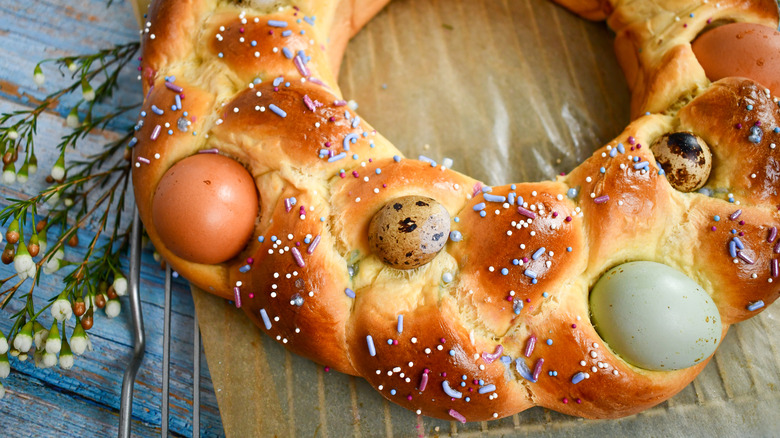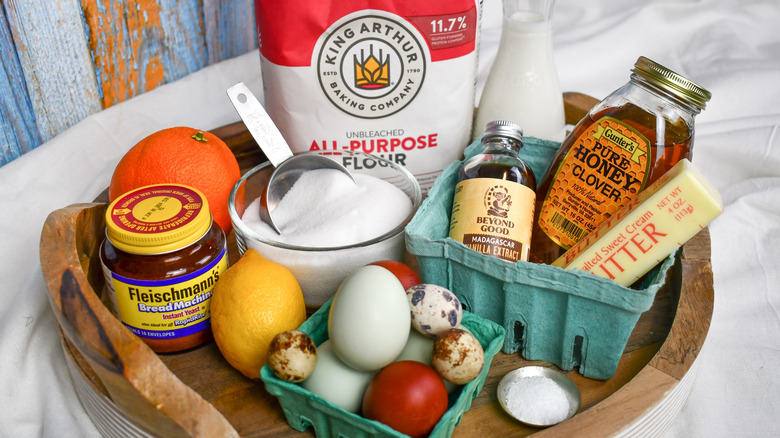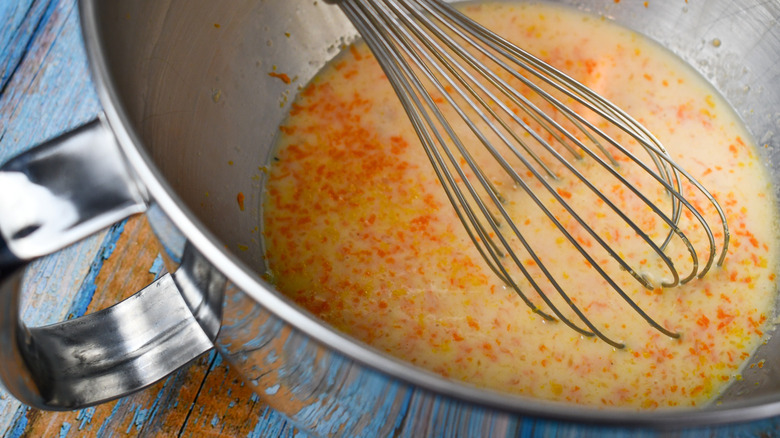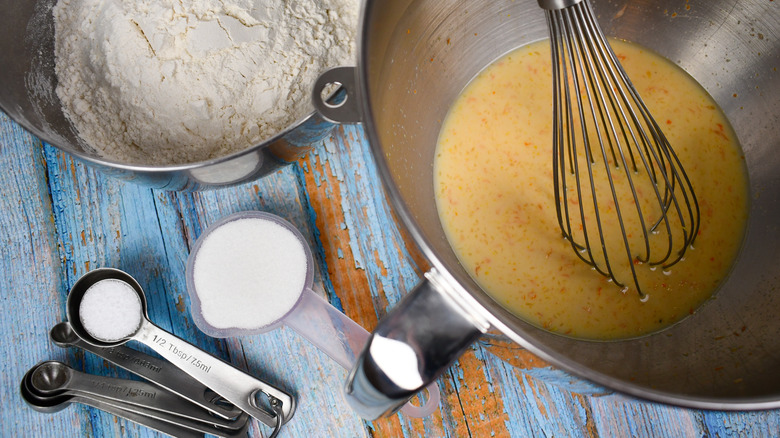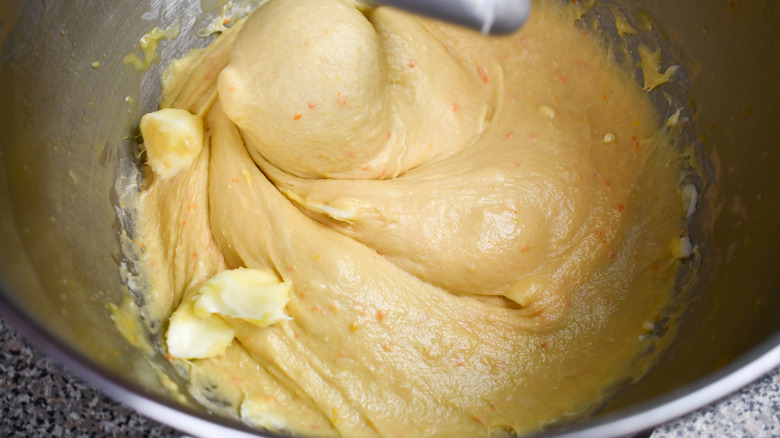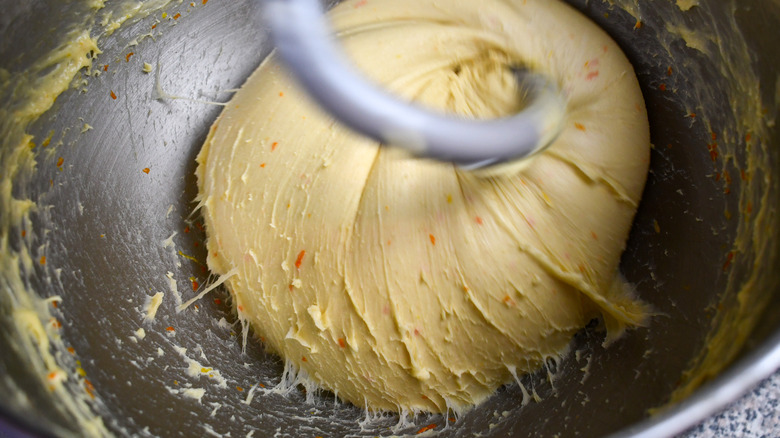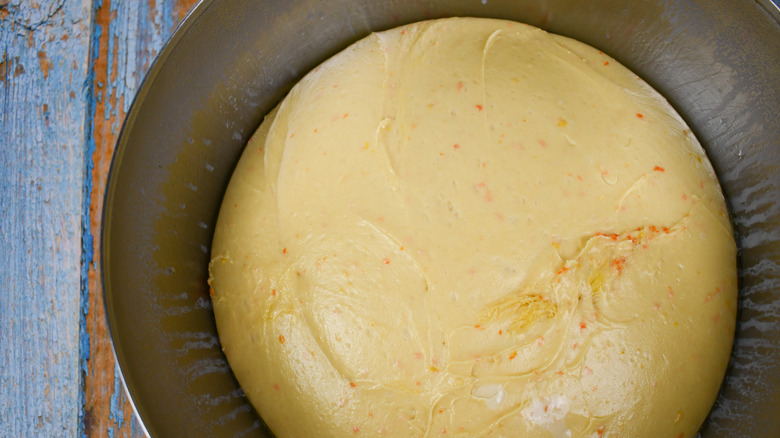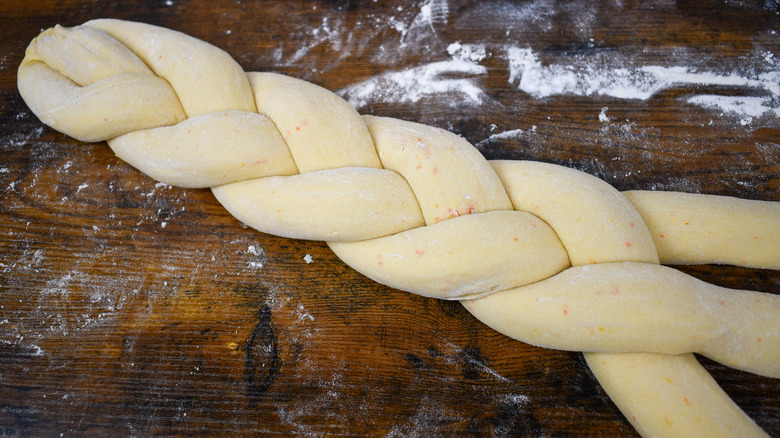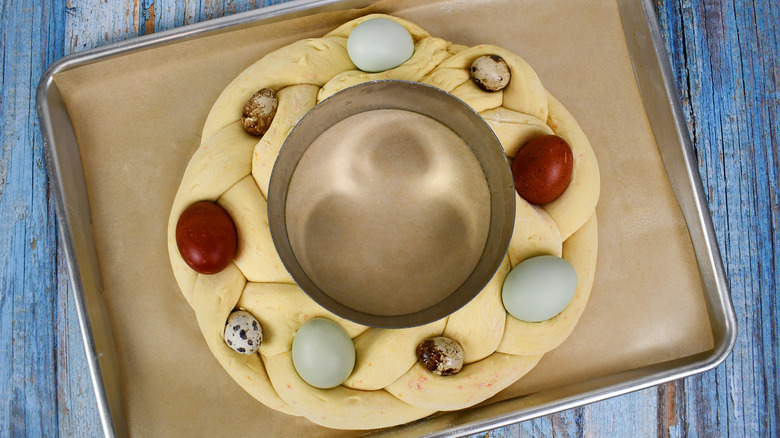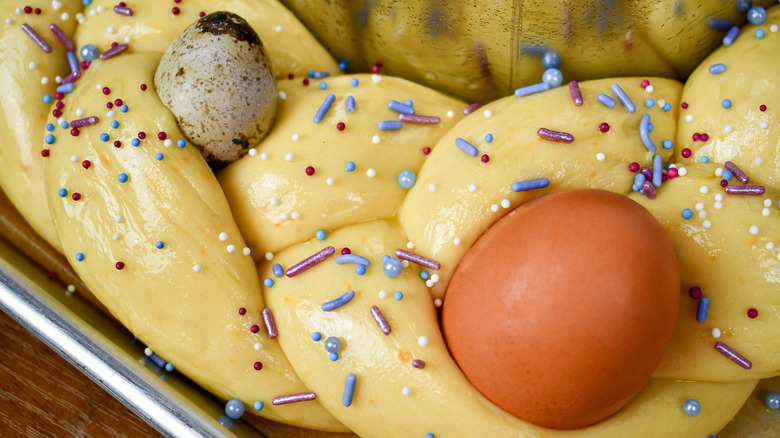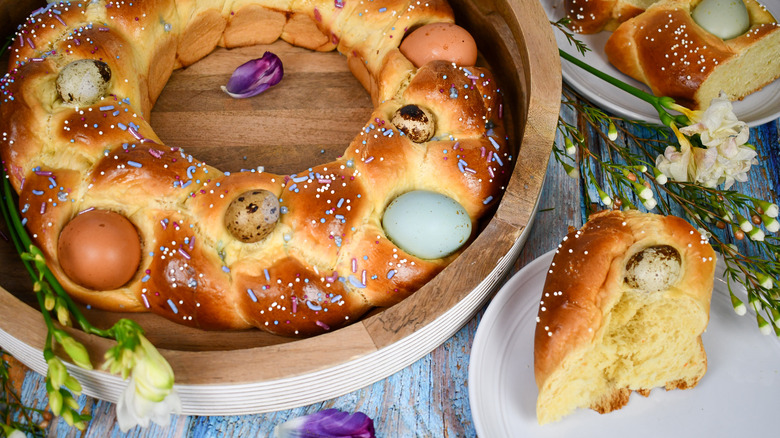Celebration Easter Bread Recipe
Easter meals look a little different for everyone, from soul-satisfying breakfast spreads and festive after-church brunches to more formal family-style dinners complete with your best dinnerware and linens. This festive Easter bread recipe is an ideal centerpiece for an Easter gathering of any kind and can be served at any point in the meal.
This brioche-style bread is enriched with butter and eggs, and an extra yolk for a little extra tenderness and flavor. It's also flavored with clover honey, orange and lemon zest, and fresh-squeezed orange juice for a slightly sweet and beautifully fragrant bread that tastes great on its own. "I like to use Cara-Cara oranges for this recipe as an affectionate goodbye to winter," says recipe developer Jenny Kellerhals. "It's a type of navel orange that's got a lovely color, is more sweet and floral than other oranges, and reaching the end of its season as spring sets in."
For those who observe the more religious aspects of the holiday, the three-strand braid is representative of the Holy Trinity, with the round shape symbolizing Christ's crown of thorns. Eggs are tucked into the bread's strands, representing the promise of new life. Finally, the bread is finished with colorful sprinkles for a celebratory touch. While this bread is slightly sweet, it's great served with salty butter, Easter ham, or a warm cup of coffee or tea while Easter egg hunts ensue. Here's how to make a celebration Easter Bread this holiday.
Gather the ingredients for the Easter bread
There's a good chance you have most of the ingredients for this Easter bread recipe in your pantry and refrigerator already if you're a regular baker. The essential ingredients include milk, a lemon and orange, vanilla extract, honey, instant yeast, eggs for baking and decorating, all-purpose flour, sugar, Kosher salt, and unsalted butter. Before mixing, the butter should soften to room temperature. Wash and dry the lemon and orange. You will also need a whisk, stand mixer with a dough hook attachment, bowl scraper, bench scraper, half-sheet tray, parchment paper, cooking spray, plastic wrap, and a pastry brush. Sprinkles to decorate are optional, and a 6-inch entremet ring or oven-safe bowl is needed to shape your dough.
We used naturally-colored blue, green, and brown heirloom eggs as well as small speckled quail eggs to decorate the bread in this recipe, but you can also use dyed or plain eggs instead. The eggs used for decorating do not need to be pre-cooked, since they'll cook while the bread is baking. Additionally, if using dyed eggs, make sure the eggs have had plenty of time to dry completely before baking to reduce the amount of colored dye that spreads onto the dough.
Mix together wet ingredients and yeast
Into the bowl of a stand mixer bowl, measure the milk, vanilla extract, honey, instant yeast, 2 whole eggs, and egg yolk. Zest the lemon and orange directly into the bowl, then squeeze and add the juice from the orange. Whisk it all together until the honey dissolves into the liquids and let the mix rest while you scale out the dry ingredients.
Add and mix the dry ingredients
Measure out the all-purpose flour, sugar, and Kosher salt. Add the dry ingredients to the wet ingredients in the bowl, then attach the bowl to your stand mixer. Fit the machine with the dough hook. On low speed (KitchenAid speed 2), mix the ingredients until they come together into a cohesive dough ball, that is no longer scrappy — about a minute.
Add the softened butter in pieces
Raise the mixing speed to medium (KitchenAid speed 5) to start developing the dough. Pinch pieces of the softened butter and add them to the mixing dough over the course of a minute. After about 3 more minutes of mixing, the butter should be completely incorporated into the dough. At this point, the dough will begin to loosen and stick to the sides of the bowl.
Finish kneading the dough
Raise the speed of the mixer once more to medium-high (KitchenAid speeds 7-9), or as high as your machine will allow without struggling or overheating. Continue to mix the dough for 7 to 10 minutes, until it pulls away from the sides and bottom of the bowl, and picks up most of the dough that rings the bowl. The dough should be strong enough to do this on its own, but you may need to help it out by scraping down the bowl once during the kneading process. If mixing at a lower speed, this process may take up to 25 minutes.
Proof and chill the dough
With a plastic bowl scraper, scrape down and lift the dough ball out of the stand mixer bowl. Quickly spray the bowl with oil, and return the dough to the bowl. Cover the bowl with plastic wrap and let the dough rise for an hour and a half in a warm place. Move the dough to the refrigerator to chill for at least 30 minutes, and up to two hours. Since this dough has a higher amount of fat, chilling the dough makes it easier to handle while shaping without over-stretching or losing its shape.
Divide and braid the dough
On a lightly-floured counter, turn the dough out of the bowl, deflate it slightly with your hands, and divide it into 3 equal pieces. Shape each piece into a log, then roll and stretch the logs into strands. Try to keep the strands about the same thickness and length. The final length should be about 24 to 26 inches long. Pinch the three strands together at one end, then braid the dough together. The braid should be tight, but not so tight that it stretches the dough strands out of shape. Once the full length is braided, leave the ends of the strands loose.
Shape and proof the dough
Line a half-sheet tray with parchment paper, and spray a 6-inch ring with cooking spray (if using). Transfer the dough braid to the sheet tray, and gently wrap it around the ring. Tuck the starting end of the dough underneath the loose ends, and braid the ends of loose strands around it to attach the ends. Gently loosen strands with your fingers to tuck in eggs, adding an egg every 2 or 3 folds. Cover the tray gently with plastic wrap and proof the dough once more for about an hour, until the dough is tender and puffy to the touch. While the dough is rising, preheat the oven to 350 F with a rack placed in the center of the oven.
If you don't have a metal baking ring, you can also use an oven-safe metal, glass, or ceramic bowl to shape your dough around. If using a glass or ceramic bowl, you can leave the bowl in place after baking for butter, dip, or anything else you'd like to serve with the bread. You can also free-form the dough into a ring.
Finish and bake the Easter bread
Beat the remaining whole egg in a small bowl for the egg wash. Remove the plastic wrap from the proofing dough, and gently paint the egg wash onto the dough with a pastry brush (the decorative eggs do not need an egg wash). Add sprinkles and nonpareils if desired, and bake for about 30 minutes. The dough will puff, and turn a rich golden-brown color. You should be able to smell the citrus and buttery sweetness once the bread gets close to finished. Remove the ring, and allow the dough to cool slightly before serving.
Enjoy the Easter bread with friends and family
Once cool enough to handle, transfer the celebration Easter bread to a decorative serving plate. It can easily double as the centerpiece for your Easter table. The bread can be sliced or torn into servings, and the baked eggs can be removed and refrigerated to be eaten later if desired. This bread is tasty enough to be enjoyed on its own, but can be served with whipped salty or sweet butter, jam, or even a dollop of cream. It also tastes great alongside baked ham and turkey, and makes for great little sandwiches with any leftovers you may have. If storing the bread, wrap it tightly with plastic wrap. If the eggs have been removed, or you don't plan on eating them, store the bread at room temperature for up to 2 days, or in the refrigerator for 1 day.
Celebration Easter Bread Recipe
This celebration Easter bread not only tastes delicious but also looks amazing as the centerpiece of a table set for brunch or dinner on the holiday.
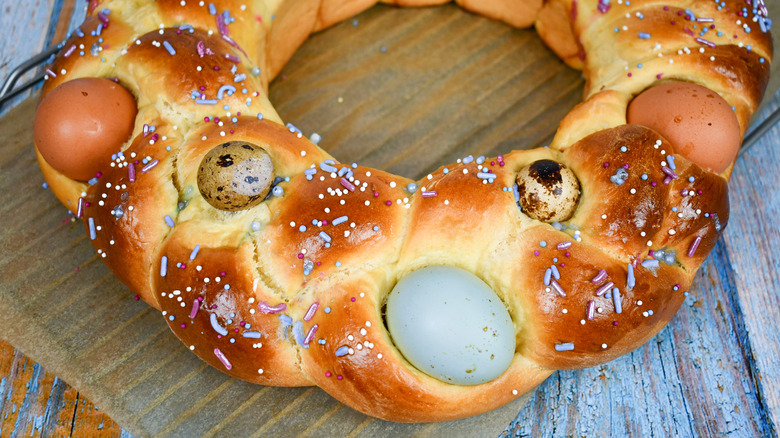
Ingredients
- ¾ cup whole milk
- 1 lemon
- 1 orange
- 1 teaspoon vanilla extract
- ¼ cup clover honey
- 2 ¼ teaspoons instant yeast (1 packet)
- 1 egg yolk
- 3 whole eggs (1 reserved for final egg wash)
- 4 cups all-purpose flour, plus more for dusting
- ¼ cup granulated sugar
- 1 ½ teaspoons Kosher salt
- 5 tablespoons unsalted butter, room temperature
- 9 eggs for decoration
- Cooking spray or oil for greasing bowl
Optional Ingredients
- Sprinkles or nonpareils
Directions
- Measure the milk, vanilla extract, honey, and instant yeast into the bowl of a stand mixer. Zest the lemon and orange directly into the bowl and whisk all of the ingredients together to combine. Juice the orange, strain, and add the juice to the wet ingredients, along with the egg yolk and two whole eggs. Whisk again to combine.
- Measure the all-purpose flour, granulated sugar, and salt into the bowl on top of the wet ingredients. Attach the bowl to the stand mixer with the dough hook attachment. On low speed, mix the dough for about a minute until it comes together in a ball.
- Raise the mixing speed to medium, and add the softened butter in pinched pieces. Continue to mix on medium speed for about 3 minutes until the butter pieces are incorporated, and the dough has begun to stick to the sides of the bowl.
- Increase the mixing speed again to medium-high, or as high as your mixer will allow without struggling. Mix for 7 to 10 minutes more, until the dough has pulled away from the bottom of the bowl and cleaned most of the dough from the sides.
- Turn off the mixer, remove the bowl from the mixer and the dough hook from the dough. With a bowl scraper, lift out the dough, quickly spray the inside of the bowl with oil, and return the dough. Cover with plastic wrap and proof at room temperature for an hour and a half. Refrigerate for 30 minutes to chill dough.
- Turn the dough out onto a lightly floured counter. Divide the dough into three equal parts, and roll each piece into a rope about 1 inch thick and 24 inches long. Line the dough strands up beside each other, making sure they're all the same length, then lightly pinch the ends together on one side. Braid the dough together with a classic 3-strand flat braid, all the way to the end of the dough, leaving the strands loose at the end.
- Transfer the braided dough to a parchment-lined half sheet pan. If desired, wrap the braid around a lightly greased 6-inch entremet ring or oven-safe bowl. Tuck the pinched starting end underneath the opposite end, and braid the ends of the strands over the starting end to attach the ends securely. Gently loosen strands with your fingers to tuck eggs into the braid, spacing them every two or three folds. Cover the bread with a piece of plastic wrap for the final proof, about 1 hour.
- Preheat the oven to 350 F while the dough proofs. Beat the remaining whole egg for the egg wash just before baking. Once the dough is tender and slightly puffy to the touch, remove the plastic wrap and brush on the egg wash. Add sprinkles or nonpareils, if using. Bake on the center rack for about 30 minutes, or until the bread is a rich golden brown and fragrant. Serve immediately, or allow to cool and wrap tightly with several layers of plastic wrap to store for up to 1 day in the refrigerator.
Nutrition
| Calories per Serving | 632 |
| Total Fat | 41.6 g |
| Saturated Fat | 6.9 g |
| Trans Fat | 0.2 g |
| Cholesterol | 186.4 mg |
| Total Carbohydrates | 53.2 g |
| Dietary Fiber | 1.7 g |
| Total Sugars | 12.2 g |
| Sodium | 329.2 mg |
| Protein | 10.9 g |
